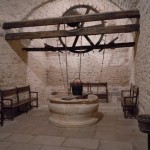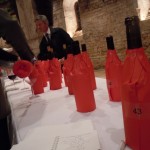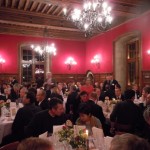Tasting 50 Burgundy 2009s blind at Clos Vougeot on 22 March 2012 + video
March 25, 2012
In recent previous visits to Burgundy, I focused on the 2009 and 2008 vintages, and generally found the 2009 for reds to be more successful. But there are exceptions, because the 2008s are tasting nicely these days. They have fine freshness, if not always the ripeness you want. On a general level, village level wines seem more successful in 2009 than in 2008. But if you go higher up the qualitative ladder, both in terms of terroir and producer, you may find the 2008s more to your liking, in terms of freshness and lift. For the whites, it is no contest. The 2008 vintage is superior, because too many 2009s lack the necessary verve and lift that one should get from fine white Burgundy, sometimes being a bit flat and listless. This notion was confirmed in a tasting of some 25 white Burgundies from the 2009 vintage on 22 March 2012 at Clos de Vougeot. But the tasting there also featured another 25 or so reds – and most were very good to utterly delicious. Succulence is the word that comes to mind for many of these reds. The best include fabulous aromatics with some complexity. The occasion was the great negociant producers of Burgundy gathering their wines under one (illustrious) roof for a blind tasting… Here the video.
TASTING NOTES BELOW (REDS and WHITES)
Blind tasting at Clos Vougeot. My overall impression was of a vintage that was successful for reds. Here we had a good representative sample, spanning both Cote de Beaune and Cote de Nuits. And the producers were not niche producers in the main; the wines came from many top negociants, 22 in all.
So an honest overall impression was attained for the 2009 vintage, which I would characterize as “warm and giving” and sometimes outright substantial. Over the past few years I have been increasing my visits toBurgundy, in part because I have a full time job now inStrasbourg, which makes a visit nothing more than a 3.5 hour car ride. Also because I am appreciating more and more the notion of freshness in wine. Which makes me rave a lot about the 2010 vintage, for both reds and whites. Unlike 2008, there is more weight and fruit, as some vintners noted – you will read soon in a future posting. 2010 is a vintage to buy in both red and white, because one encounters freshness and ripeness.
In 2009, the danger is a bit of over-ripeness, especially with regard to the whites. And at Clos Vougeout, I encountered some bad examples of cloying white, when not simply lacking verve. The reds are mostly successful, so read on!
Tasting notes 2009s (wines in bold, I liked; in red and bold, even more; when underlined, the very best)
Chablis Les Blanchots Maison Laroche. A bit warm and bland. Abrupt finish.
Chablis Les Blanchots Maison Lupe Cholet. Juicier, more interesting, but nothing too memorable either.
Chablis Les Clos Jean Marc Brocard. This has a fine herbal aspect, with full bodied nature, if not as precise as I would have expected. Good.
Chablis Les Clos Maison Laroche Lovely sap, with richness and decent verve, the best yet.
Chablis Les Clos William Fevre. A touch warm, not as good as the previous two.
Chablis Bougros William Fevre. I found this more interesting than the Les Clos, displaying more freshness, but slightly monotone and even short on the finish.
Chablis Moutonne Albert Bichot. There is a suave aspect to this wine, but I felt it was short on the finish. I have had better vintages of this wine.
Chablis Vaudesir Maison Louis Moreau. This wine, tasted blind, particularly pleased me for its crackly green apple freshness, and fine purity. Nice job!
Chablis Vaudesir Maison Moreau and Fils. There is something out of focus here on the palate, lacking the precision of the above, although not warm… OK.
Chablis Les Preuses Maison Simonnet-Febvre. Halloween caramel red apple aromas and flavors. Fine medium bodied feel, touch of spice. Will not make old bones, but pleasing today.
Corton Charlemagne Maison Michel Picard . This was fine. Smooth and elegant red apple freshness. Fresh finish, I really liked this.
Corton Charlemagne Maison Seguin Manuel. Touch warmer than above, but not bad either.
Corton Charlemagne Maison Henri de Villamont. The overall impression I obtained here was one of austerity on the palate…
Corton Charlemagne Maison Corton Andre. A fine fresh aspect, but just a bit monolithic, lacking precision… again a somewhat common trait for white 2009s…
Corton Charlemagne Maison Roux Pere & Fils. Fine aromatics promise great things perhaps but the palate is, again, warm and even a bit thick in texture.
Corton Charlemagne Maison Louis Jadot. This is quite a success in light of the vintage character. I sensed ripe herbal aromas… whatever you think that may mean. A frank attack, turns a touch viscous on the mid palate, and a touch warm, but overall, more balanced than most of the others.
Corton Vergennes Chanson Pere & Fils. A certain aggressive nature here.
Batard Montrachet Maison Louis Latour. Some people found this downright sweet. While I would not go that far, it was rich and hefty and hardly subtle, with heat on the finish. Avoid this 2009, unless you like typical California Chardonnay…
Batard Montrachet Maison Jean Marc Boillot. Here a far better wine, stricter, with acidity helping out. More interesting. Although I would seek out a 2008 or 2010…
Batard Montrachet Maison Drouhin. Again, better than the Louis Latour, but not quite as good as the above. I get more of a “sweet” aspect here, when compared to the Boillot. Not bad, but not great either.
Chevalier Montrachet Bouchard Pere & Fils. Well, here is the white of the series, coming from a cooler terroir more to the north in the great Montrachet region… and this really proved advantageous in 2009. Rather brisk in comparison to the preceding wines, and also full bodied. Very nice job.
Overall, the reds proved to be far more a pleasure to taste than the whites. As is often done in Burgundy, I tasted the reds first. Hoping to get some freshness from the whites afterwards. But the reds proved even fresher than the somewhat heavy and monolithic whites…
Corton Maison Joseph Drouhin. Lovely nose. Some licorice aspects and fine verve on the palate.
Corton Maison Bouchard Pere & Fils. Here we have a warmer nose, with black rather than red fruit. A more 2009 like wine, perhaps, and there seems to be more oak coming through, but well integrated. Another style that I also like, but I would have spent more time comparing the two if we had had more time… Nice job.
Corton Maison Prosper Maufoux. Fine substance on the palate, rich, although there seems to be an oaky aspect that is too present, but a good tonicity on the finish.
Corton Bressandes Maison Corton Andre. Famous estate. Do I get a bit of furry tannin on the nose? Certainly spicy on the ripe and pleasing medium plus bodied palate.
Corton Pougets Maison Louis Jadot. Cooler nose here, albeit with oak derivation, but overall a tighter tannic aspect. More interesting to me than the above.
Corton Perrieres Maison Louis Max. Here we have more fruit up front, but the tannins seem a touch coarse on the palate…
Corton Fietres Maison Michel Picard. A vanillin nose that seems oak derived, then very oaky on the palate. Where is the fruit? Drying tannins. A poor 2009 red to be sure, and thankfully rare…
Corton Renards Maison Stephane Brocard. This has fine focus and depth, with sap on the palate albeit a touch hot on the finish…
Corton Renards Maison Roux Pere & Fils. Hottish, somewhat oak derived, monotone.
Clos de Vougeot Maison Lupe Cholet. Rather intense nose, although a touch warm, with a somewhat unrefined tannins, displaying austerity…
Clos de Vougeot Maison Bouchard Aine & Fils. A more impressive nose, even perfumed, although I get a sense of some drying on the finish.
Clos de Vougeot Maison Seguin Manuel. More fruit here, showing good sap on the mid palate, not drying out, if a touch warm.
Clos de la Roche Maison Jean Claude Boisset. Even more sap, freshness, too with black fruits… this is very impressive. Michael Apstein gave it 3 stars. I would agree.
Clos de la Roche Maison Bouchard Aine & Fils. A more iodine aspect here, cooler, although is there some animal evolution on the palate already? This is good however.
Chambertin Maison Pierre Bouree & Fils. Lovely nose here, enveloping palate, rich and opulent, if a touch drying and warm, but not too much so.
Charmes Chambertin Maison Louis Max. Lovely, pure aromas and flavors, Not drying on the finish, not hot. Superb.
Chambertin Clos de Beze Chanson Pere & Fils. Stony mineral nose, rich and velvety palate, but also quite precise, shutting down a bit on the finish but in a good sense, signs of capacity to age. Nice job.
Grands Echezeaux Maison Henri de Villamont. Very deep red floral aromatics, velvet? Impressive velvet palate feel, fine tannins, full bodied yet nuanced, is there a hint of 2009 heat? Yes, but this is darn good. I just loved this!
Echezeaux Maison Albert Bichot. Lovely floral bouquet, more delicate than the above, and perhaps fresher on the palate, but it does not wow as much overall as the preceding wine… still, a fine wine to be sure.
Echezeaux Maison Jean Claude Boisset. More a mix of ripe red and black fruit on the nose and palate. Is there a bit of oak derivation coming to the fore? There is sap, and it is not drying. Needs time to resolve itself? Fine potential.
Romanee Saint-Vivant Louis Latour. Now, I did not spit this. Rich, sap-filled and complete. One understands the terroir hierarchy ofBurgundywith this last wine. I get some spice, some clove as well, with white pepper and then an added tonicity on the finish that is not as often encountered as one would like with many 2009s. This is superb, requires a double underline…





[…] are thoroughly appealing, the 10s often seem to have more balance and freshness. Just one day after an amazing tasting of 50 2009s at Clos de Vougeot, I sought out the 2010 […]
Works great! and the explanation are very well done, thanks ;=)
Hi there, I enjoy reading through your post.
I wanted to write a little comment to support you.